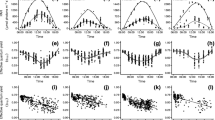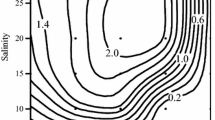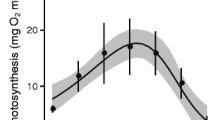Abstract
Main effects and interactions of light and temperature on rates of growth (μ), net photosynthesis (Ps), and dark respiration (R) of the red seaweedGracilaria tikvahiae were investigated in outdoor, nutrient-replete continuous-flow seawater culture chambers. Below 15°C,G. tikvahiae did not grow and between 15° and 30°C, both main effects and interactions of light and temperature on μ and Ps were significant, which explains the occurrence of this alga as a summer annual in its northern range. Temperature interacted with light (I) through its influence on the μ vs I and Ps vs I curves. The initial slope of the μ vs I curve, α, the light saturation intensity, Is, and maximum growth rate, μmax, were all significantly lowerat 15°C compared to 20°, 25°, or 30°C. Maximum values of μmax, the Ps:R ratio and the net photosynthesis:gross photosynthesis ratio (Ps:Pg) all occurred at 25°C, suggesting that this is the best temperature for growth ofG. tikvahiae. Values for Pmax increased up to 30°C, indicating that the temperature for maximum growth and net photosynthesis are not the same forG. tikvahiae. Significant photoinhibition of growth and photosynthesis at full incident sunlight (I0) occurred at 15°C but not at 20°, 25°, or 30°C. Steele's equation fit the 15°C μ vs I data best, whereas the hyperbolic tangent function fit the 20°, 25°, and 30°C data best. Main effects and interactionof light intensity and temperature on rates of R were also significant (P<0.001). R was highly intercorrelated with μ and Ps (0.86≦r≦0.94), indicating that R inG. tikvahiae is primarily regulated by growth rate and not temperatureper se. Environmental factors that regulate growth, such as light intensity, exert a great influence on R inG. tikvahiae.
Similar content being viewed by others
Literature cited
Baly, E. C. C.: The kinetics of photosynthesis. Proc. R. Soc. Lond. Ser. B.117, 218–239 (1935)
Bannister, T. T.: Production equations in terms of chlorophyll concentration, quantum yield, and upper limit to production. Limnol. Oceanogr.19, 1–12 (1974)
Beevers, H.: Respiration in plants and its regulation.In: Prediction and measurement of photosynthetic productivity, pp 209–214. Pudoc. Wageningen 1970
Bolton, J. J. and K. Lüning: Optimal growth and maximal survival temperatures of AtlanticLaminaria species (Phaeophyta) in culture. Mar. Biol.66, 89–94 (1982)
Brinkhuis, B. H.: Seasonal variations in salt-marsh macroalgae photosynthesis II.Fucus vesiculosus andUlva lactuca. Mar. Biol.44, 177–186 (1977)
Durako, M. J. and C. J. Dawes: A comparative seasonal study of two populations ofHypnea musciformis from the east and west coasts of Florida, USA II. Photosynthetic and respiratory rates. Mar. Biol.59, 157–162 (1980)
Eppley, R. W.: Temperature and phytoplankton growth in the sea. Fish. Bull., U.S.70, 1063–1085 (1972)
Gessner, F.: Temperature: plants.In: Marine ecology. Vol. 2 (1). Ed. by O. Kinne. New York: Wiley-Interscience 1970
Goldman, J. C.: Outdoor algal mass cultures II. Photosynthetic yield limitations. Water Res.13, 119–136 (1979)
Hanisak, M. D.: Growth patterns ofCodium fragile spp.tomentosoides in response of temperature, irradiance, salinity and nitrogen source. Mar. Biol.50, 319–332 (1979)
Harris, G. P.: Photosynthesis, productivity and growth: the physiological ecology of phytoplankton. Ergeb. Limnol.10, 1–171 (1978)
Hellebust, J. A.: Light: plants.In: Marine ecology, Vol. 1 (1). Ed. by O. Kinne. New York: Wiley-Interscience 1970
Hochachka, P. W. and G. N. Somero: Strategies of biochemical adaptation, 358 pp. Philadelphia: W. B. Saunders 1973
Hulburt, E. M. and R. R. L. Guillard: The relationship of the distribution of the diatomSkeletonema tropicum to temperature. Ecology49, 337–339 (1968)
Jassby, A. D. and T. Platt: Mathematical formulation of the relationship between photosynthesis and light for phytoplankton. Limnol. Oceanogr.21, 540–547 (1976)
Johnson, F. H., H. Eyring and F. J. Stover: The theory of rates and processes in biology and medicine. New York: Wiley, 1974
Jones, R. I.: The importance of temperature conditioning to the respiration of natural phytoplankton communities. Br. phycol. J.12, 277–285 (1977)
Jorgensen, E. G.: The adaptation of plankton algae. II. Aspects of the temperature adaptation ofSkeletonema costatum. Physiol. Plant.21, 423–427 (1968)
Kanwisher, J. W.: Photosynthesis and respiration in some seaweeds.In: Some contemporary studies in marine science, pp 407–420. Ed. by H. Barnes, London: Allen and Unwin 1966
Lapointe, B. E. and J. H. Ryther: Some aspects of the growth and yield ofGracilaria tikvahiae in culture. Aquaculture15, 185–193 (1978)
Lapointe, B. E. and K. R. Tenore: Experimental outdoor studies withUlva fasciata Delile. I. Interaction of light and nitrogen on nutrient uptake, growth, and biochemical composition. J. exp. mar. Biol. Ecol.53, 135–152 (1981)
Laws, E. and J. Caperon: Carbon and nitrogen metabolism byMonochrysis lutheri: measurement of growth rate dependent respiration rates. Mar. Biol.36, 85–97 (1976)
Lederman, T. C. and P. Tett: Problems in modelling the photosynthesis-light relationship for phytoplankton. Bot. Mar.24, 125–134 (1981)
Li, W. K. W.: Temperature adaptation in phytoplankton: cellular and photosynthetic characteristics.In: Primary productivity in the sea, pp 259–279. Ed. by P. Falkowski. New York: Plenum Press 1980
Mathieson, A. C. and T. L. Norall: Physiological studies of subtidal red algae. J. exp. mar. Biol. Ecol.20, 237–247 (1975)
McLachlan, J.:Gracilaria tikvahiae sp. nov. (Rhodophyta, Gigartinales, Gracilariaceae), from the northwestern Atlantic. Phycologia18, 19–23 (1979)
Meeks, J. C. and R. W. Castenholz: Growth and photosynthesis in an extreme thermophile,Synechococcus lividus (Cyanophyta). Arch. Mikrobiol.78, 25–41 (1971)
Michaelis, L. and M. L. Menten: Der Kinetic der invert Inwirkung. Biochem. Z.49, 333–369 (1913)
Morris, I. and K. Farrel: Photosynthetic rates, gross patterns of carbon dioxide assimilation and activities of ribulose diphosphate carboxylase in marine algae grown in different temperatures. Physiol. Plant.25, 372–377 (1971)
Morris, I. and H. E. Glover: Questions on the mechanism of temperature adaptation in marine phytoplankton. Mar. Biol.24, 147–154 (1974)
Newell, R. C. and V. I. Pye: Seasonal variations in the effect of temperature on the respiration of certain intertidal algae. J. mar. biol. Ass. U.K.48, 341–348 (1968)
Nie, N. H., C. H. Hull, J. G. Jenkins, K. Steinbrenner and D. H. Bent: Statistical package for the social sciences, 675 pp New York: McGraw-Hill 1975
Precht, H.:In: Physiological adaptation, Ed. by C. L. Prosser. Washington: American Physiological Society 1958
Rabinowich, E. I.: Photosynthesis and related processes, Vol. II, part 2. New York: Interscience 1956
Ramus, J.: Seaweed anatomy and photosynthetic performance: the ecological significance of light guides, heterogeneous absorption, and multiple scatter. J. Phycol.14, 352–362 (1978)
Raven, J. A. and S. M. Glidwell: Photosynthesis, respiration and growth in the shade algaHydrodictyon africanum. Photosynthetica,9, 361–371 (1975)
Rhee, G. Y. and I. J. Gotham: The effect of environmental factors on phytoplankton growth: temperature and the interactions of temperature with nutrient limitation. Limnol. Oceanogr.26, 635–648 (1981)
Sears, J.: Morphology, systematics and descriptive ecology of the sublittoral benthic marine algae of southern Cape Cod and adjacent islands. Ph.D. dissertation, University of Massachusetts 1971
Silvert, W.: Practical curve fitting. Limnol. Oceanogr.24, 767–773 (1979)
Snedecor, G. W. and W. G. Cochran: Statistical methods, 593 pp. Ames: Iowa State University Press 1967
Soeder, C. J. and E. Stengel: Physico-chemical factors affecting metabolism and growth rate.In: Algal physiology and biochemistry. Ed. by W. D. P. Stewart. Oxford: Blackwell 1974
Sorokin, C.: Tabular comparative data for the low and high temperature strains ofChlorella. Nature, Lond.184, 613–614 (1959)
Spencer, C. P.: Studies on the culture of a marine diatom. J. mar. biol. Ass. U.K.33, 265–290 (1954)
Steele, J. H.. Environmental control of photosynthesis in the sea. Limnol. Oceanogr.7, 137–150 (1962)
Steemann-Nielsen, E. and E. G. Jorgensen: The adaptation of plankton algae. I. General Part. Physiol. Plant21, 401–422 (1968)
Strickland, J. D. H. and T. R. Parsons: A practical handbook of seawater analysis, 2nd edition, 310 pp. Ottawa: Res. Bd Can. 1972
Talling, J. F.: Photosynthetic characteristics of some freshwater plankton diatoms in relation to underwater radiation. New Phytol.56, 29–50 (1957)
Taylor, W. R.: Marine algae of the northeastern coast of North America, 509 pp. Ann Arbor. University of Michigan Press 1957
Taylor, W. R.: Marine algae of the eastern tropical and subtropical coasts of the Americas, 870 pp. Ann Arbor: University of Michigan Press 1972
Yoder, J.: Effect of temperature on light-limited growth and chemical composition ofSkeletonema costatum (bacillariophyceae). J. Phycol.15, 362–370 (1979)
Zavodnik, N.: Seasonal variations in rate of photosynthetic activity and chemical composition of the littoral seaweeds common to the North Adriatic. Part I.Fucus virsoides (Don). J. Ag. Bot. Mar.16, 155–165 (1973)
Author information
Authors and Affiliations
Additional information
Communicated by J.M. Lawrence, Tampa
Rights and permissions
About this article
Cite this article
Lapointe, B.E., Tenore, K.R. & Dawes, C.J. Interactions between light and temperature on the physiological ecology ofGracilaria tikvahiae (Gigartinales: Rhodophyta). Mar. Biol. 80, 161–170 (1984). https://doi.org/10.1007/BF02180183
Accepted:
Issue Date:
DOI: https://doi.org/10.1007/BF02180183




